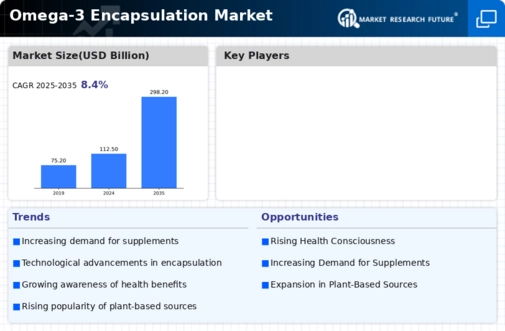Market Trends
Key Emerging Trends in the Omega 3 Encapsulation Market
Omega 3 Encapsulation Market is showing significant trends in line with growing awareness of the health benefits associated with omega-3 fatty acids. One key area shaping this broad field is the rise in demand for omega-3 capsules. Overall well-being, cognitive function, and heart health, among others, are some of the reasons why consumers now acknowledge the significance of these nutrients in their body systems, thereby demanding such fortified foods (Silva et al., 2014). Similarly, it can be observed that there is a booming demand for functional foods supplemented with encapsulated omega-3 (Casa et al., 2015). In response to consumer calls for better nutrition through eating, encased omega-3 fats have been integrated into various food products such as dairy, snacks, and beverages, such as bakery, among others. Hence, it makes them healthier (Makino et al.,2015). Foods containing these ingredients help maintain both nutrient levels and flavor profiles while protecting them from breakage during storage through the use of microparticles loaded with ω-3s at different concentrations (Qiao et al.,2016). The ingredients themselves also offer nutritional support since they provide flaxseed oil, fatty acids, and saturated fats (Casa et al., 2015). There is also a strong trend toward diversification in the omega-3 encapsulation market. In order to improve the solubility and stability of omega-3 fatty acids, companies have developed a number of technologies, including microencapsulation and electrostatic hydrogel encapsulation, among others. The encompassed methods, as well as nanoencapsulation and microencapsulation, offer a solution to some challenges that are inherent in ω-3 fatty acids, such as susceptibility towards oxidation or taste alteration (Qiao et al., 2016). Sustainability has come up as one of the factors influencing the Omega 3 Encapsulation Market. Concerns over depleted fish supplies and environmental hazards have necessitated responsible procurement of omega-3 products by customers. As a result, there is an increased demand for algae oil-based encapsulated ω-3's, which are sustainably sourced (Casa et al., 2015). Producers, on the other hand, are trying to show their commitment to sustainability, whether it is in sourcing or production. The digital age has also contributed to shaping market trends through online platforms that serve as channels for marketing and distribution of omega-3 encapsulated products. E-commerce enables consumers to find different types of omega-3 supplements and fortified foods conveniently. Furthermore, digital marketing and social media take part in educating customers on the importance of omega-3 benefits that accrue during its use, together with merits relating to the use of encapsulation technology. Manufacturers utilize online platforms to engage with consumers, share information about their products, build brand loyalty, and ensure that they influence purchasing decisions through this rich pool of accessible information found online.



Leave a Comment